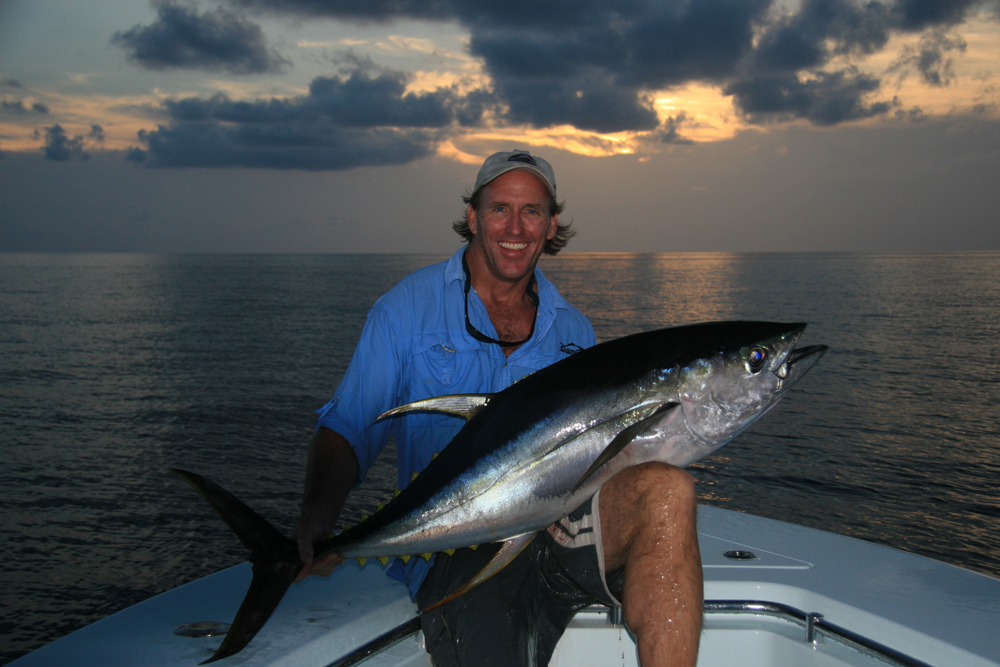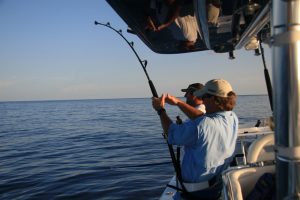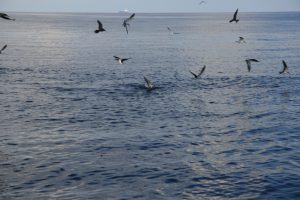March 27, 2012
By Frank Bolin
Panning for Gold: High-tech fishing for yellowfin tuna on the far edge of the Gulf Stream.

A hundred-mile trek in an open boat takes on a new dimension when your path crosses the Gulf Stream. Even on calm days, this hard-flowing Atlantic current seethes and writhes, pulsating in reckless rhythm while pushing a steady torrent of blue-black water northward. Mariners' legends recall how quickly the Stream can blow up, tossing wavecrests skyward into frothy, whitewater peaks-beautiful, yet dangerous.
But anglers know that piscine treasures prowl beyond the eastern boundary of the Gulf Stream. Each summer, more and more fishermen outfitted to make the long run are striking gold in the form of yellowfin tuna schools.
It's the kind of fast-paced, energetic fishing that brings dedicated anglers back for more, season after season. In the predawn hours, I arrived at Port Canaveral for my first trip, but by day's end, I would be ready for more.
"Are you bound and determined?" a lone voice, hidden in the dark behind the console gibed. "You gotta be tough to play the tuna game."
It was Keith Lawhun, captain of Barely Rigged. The time? Sometime between three and four a.m. Across the planks, silence hung like an old glove. We were a good two hours ahead of the usual port early birds.
Seventy-five miles of bumpy Atlantic later I was still bound and determined. While bouncing across a particularly nasty stretch, Keith leaned back and said, smiling, "only 25 miles to go." The roar of 450-outboard horses in full rev kept conversation to a minimum. In our crew of five, three of us were first-timers. We witnessed a glorious sunrise. Keith never slowed down. His words as we passed the sea buoy rang in my ears: "You gotta get there to fish there."
After crossing the east wall of the Gulf Stream, Lawhun backed off the throttle long enough to adjust the radar. Following a 3-hour run at 30 knots, the solitary nature of our venture struck me. In all directions, open ocean stretched for miles. Nary a soul in sight. Not even on radar. We were alone, five anglers aboard a slick center console, seeking guidance from the occasional blips echoing across the radar screen.
Lawhun gave us fair warning, gunned the boat, and sped off toward a small, fuzzy, green target pulsing on the radar screen.
"Fish ahead. Get ready. Drop 'em in now!" he bellowed. "They're coming our way."
He pointed at a small blip moving at a fast clip to ground zero-our boat. Birds flew into view, wheeling, dipping and screeching, scant feet above the surface. Under them, the turquoise water churned like a cauldron as yellowfin tuna streaked and struck, sending plumes of water into the air.
Mate Rob Smith spooled out the shotgun offering, a black Todd's Barrel Head lure. He slammed the 50-pound-class trolling reel into gear when a good quarter of the line trailed behind the transom. We ran similar lures tighter-thankfully-from the outriggers, some 75 yards back, and clipped two flatline diving plugs, Braid Speedsters, into place, a mere 40 yards off the stern.
Keith wheeled the boat to port, dragging the lures in a wide arc to intercept the leading edge of the melee. "Watch your baits," he said.
The skipper's words were lost in the high-decibel scream of four 50-wides dumping line as yellowfins blistered horizon-bound under full steam, despite the 15-pound drag strike setting. Lawhun jammed the throttles, pushing Barely Rigged from her 10-knot trolling speed up to 15 or more. He turned away from the pack, eased off the throttle and started laughing, watching his crew performing the cockpit shuffle. Not one of us had anything close to half a spool of line on our side.
We were knee-deep in a cockpit brawl. Tony, A.Z., Rob and I wrestled for every inch of line. Five baits in the spread. Four yellowfins on the hook. On the first pod we encountered. Is making the trip worth it? You bet.

On that July morning, Lawhun's description of using radar to chase yellowfin tuna finally came to jell. At the core of our success was technology. Savvy anglers have discovered that monitoring radar is the most efficient way of locating yellowfins in the wild bluewater yonder. Properly tuned, radar can pick up the seabirds that follow the same types of forage as the tuna schools. Think of it as a way to expand your view from one-half to nearly six miles. It's kinda like using a magnet while searching for the proverbial needle in a haystack.
Two Port Canaveral captains, Ed Dwyer and Mike Kane, are widely credited for developing and perfecting a radar technique for the Florida east coast tuna fishery. In the early '90s, Dwyer's Ticket and Kane's Whitewater broke the ice for what would become a yellowfin bonanza. Their exploits are well-chronicled ("Canaveral's Yellowfin," FS, Nov. '95). In recent years, anglers have been adapting the methods to smaller boats and outboards. Lawhun put in a lot of effort rigging his 34-foot boat to chase tuna beyond the east wall.
He quizzed electronics experts. Most suggested something from the Furuno line. Logging on, Lawhun gleaned information from Furuno's Web site. Durability also factored into his formula. Lawhun needed a unit that would withstand the rigors of repeated high-speed charges across the Gulf Stream.
"Furuno recommended the 1942 radar model, saying it was perfect for the task," he said. "I believe it. We've broken everything on the boat except the radar."
"For power, I chose a 6 kW radar. It's a good match for my boat. A 4 kW will do the job, but it's really not strong enough. Since Barely Rigged is a low-profile hull, 10, 12 or 18 kW units didn't offer any serious advantage. I can't mount them high enough above the water to utilize the extra power."
His choice is a favorite among the radar tuna crew.
A quick tip: If you're thinking about adding radar to your vessel, stick with open ray units, the ones with a revolving T-bar. Steer clear of the dome models for tuna chasing.
Mounted above the deck on a beefy radar arch, the Furuno 1942 6 kW unit gives Lawhun the ability to "see" a flock of birds (out there they're called pods) in any direction from a distance of up to six miles. It will also read pods of two to four birds from two to three miles away.
Getting dialed in is the key to locating birds. On Barely Rigged, Lawhun switches the screen to a 6-mile radius. His procedure incorporates increasing the rain and clutter controls to max to eliminate both. Next, he turns up the gain until a light green haze, or echoes, fill the screen. Back off the gain knob until the light green color just star
ts to disappear. You're set. Birds will show as tiny, green blips. Often, they'll "blip" on every other rotation until you close in on the target. It takes a few tries to get the setup wired, but once you do, you'll keep your eyes glued to the screen.
Another radar believer is Dave Rogers of Daytona Beach, who fishes aboard the 29-foot Caymar. Rogers cut his tuna eyeteeth hunting for yellowfin the old-fashioned way, relying on eyeball power. Three years back, Caymar's owner, Dave Heine, installed radar, also a Furuno 1942 6 kW. Rogers likes the change.

"With radar we can spot birds, rips and weedlines," he said. "Our vision increased from one-half mile of eyeball power to about six miles." He stresses getting the machine dialed in. "Make sure to turn up the gain enough to pick up birds."
Rogers fishes mostly out of Ponce Inlet. Lawhun divides his time between Ponce, Port Canaveral and Ft. Pierce. Although their techniques and rigging differ, they employ many of the same strategies for pursuing tuna by radar.
Both say the season kicks off by early May and lasts through the end of August. Each year the run begins with the teenagers showing first. From mid-season on, the bigger brutes arrive. Mid-July to mid-August offers the best shot at big fish. "That's when the 60-, 80-, and 90-pounders fire off," Lawhun said.
Both also agree on another point: The biggest tuna roam the waters beyond the Gulf Stream. A favorite zone is an area five to ten miles past the east wall.
"We usually fish east of the current, normally between 75 to 80 miles off, depending on the location of the east edge," said Rogers. "As the season develops, the run often shifts a little farther out. Yellowfins off Daytona are actively chasing baits, moving all the time."
Approaching a feeding tuna pod requires moving with the fish, team effort and speed. Rogers and Lawhun prefer lures on the strength of the latter requirement.

The trick is to work the leading edge of the pod and never troll through the pack. Placing lures in front of the fish often means pulling baits at speeds up to 16 knots. Naturals won't hold together. Lawhun puts out lures a solid quarter-mile short of the fish, and adjusts his approach accordingly. He refuses to approach diving birds without lures in the water.
Ten knots is pretty much the standard trolling speed. Barely Rigged trolls a spread of Todd's Large Barrel Head lures, rigged with 90-degree offset hooks, on the shotgun and rigger lines, and Braid Speedsters on the flatlines. The Barrel Heads are 11-inch skirted lures with concave heads designed to create a fish-attracting trail of bubbles; they are especially popular among anglers in East Central Florida (where the lures are made and sold), but are similar to a great many lures on the market. The Speedsters are double-hooked, lipless diving plugs.
Caymar's spread consists of Geosonic Flying Fish (skirted, flat-faced lures in small and medium sizes), Todd's, Big T's (zucchini color was their top producer last season), and Braid Speedsters. Rogers rigs lures with two Mustad SS 7732 hooks, sized to the lure, stiff-rigged with a 180-degree offset. He is also experimenting with 15/0 circle hooks, single-rigged, flip-flop style.
Standard tackle for East Coast yellowfins is 50-pound trolling gear. Lawhun's arsenal consists of two-speed Shimano Tiagra 50-wides, mounted on custom rods. Rogers favors 50-wide Penn Internationals. Tuna sticks need backbone, a fast action and roller tips. Penn, Shimano, Braid, G. Loomis and Star manufacture tools built for the job, as do a number of Florida custom builders.
Rogers, who's worked in the tackle shop business for years, opts for a rod of his own creation. It's a modified 50- to 80-pound-class Shakespeare Ugly Stik cut down to accept a size 20 roller tip, and re-fitted with an aluminum gimbal. This rod's definitely not spongy. He also recommends Penn Mariner Standups, model 660 CHST, 6-foot, given the same modifications.
Whatever you do, don't forget to pack a good fighting belt. Opt for the kind that spans both knees, and wear 'em low. If you own a shoulder harness, kidney belt or standup harness, even better. Tuna pumping ain't a light-tackle showdown. Lawhun sets strike drag at 15 pounds, fightin' drag at 23. I still remember the rifle-crack report of Keith's rod snapping when A.Z. bullied a hefty yellowfin out of the props.
For terminal tackle, wind-on leaders get the nod among the tuna crew. Stock fare is a 25-foot wind-on, crimped to a ball bearing marlin swivel. Sampo's 165- and 200-pound sizes are good choices. Rig lures with 200-pound mono. Rogers uses Jinkai or Momoi. Finish all connections with crimps and chafing gear-stainless chafing springs (loop protectors) on small lures, thimbles on large lures. It's a good idea to keep leader length between six and 10 feet. Shorter leaders are a lot easier to handle in the cockpit. The last step? Sharpen your hooks! Ditto the rigs for the Speedster plugs.
Perhaps the most exciting element of radar tuna fishin', besides charging the Gulf Stream at 30 knots, is the multiple hookup factor. Yellowfin tuna don't dine alone. Multiples are common. Seventy-five percent of the time, maybe more, every lure in the spread gets nailed by yellowfins averaging in the 30- to 40-pound class.
There are times, though, when you must coax the second, third, fourth and fifth fish into striking. Two strategies produce. Rule number one is never slow down. Either dump the reels, throw them back into gear and let them drop until the boat jerks them up. Or, jig 'em up by grabbing the line and jigging it. This method works best on rigger baits. Take care not to wrap the line around your hands or fingers. That would ruin the trip. Remember, tuna are certified gamefish. Play it safe.
Dealing with multiples, hooked fish blazing off in every direction, requires teamwork. Often, tuna will turn and run with the boat. Always bring in the short fish first. Why reel the shotgun line through a monofilament gauntlet just because it got hit first? Lawhun has another tip. If needed, put your rodtips together. You'll be able to tell whose line is over or under whose.
Tempting the tuna grounds ain't like hittin' your 'round-the-corner fishing hole. Every time I go I return tired, bruised and satisfied, the thrill of screamin' 50s still buzzing in my head.
Learning Curve
Heading for parts unknown, guided by radar, 60-plus miles offshore, requires common-sense preparation. Out here, there is no one to call, even if you could reach them. Carry spare everything-props, oil, parts, water and fuel. Twin motors are highly recommended. Fuel is a major concern. Know your fuel burn, and leave a safety margin.
Tuna Tidbits
Before radar fishing gained popularity, anglers used to fish the weather buoy located 120 miles off New Smyrna. Daytona's late Frank Timmons Sr. helped pioneer the way, aboard his Escape Hatch II, for an entire bluewater generation. In 1982, Da
ytona Beach angler Charlie Schammel landed a 149.5-pound yellowfin out of Ponce Inlet. Marlin often crash the party. Blues to 300 pounds are landed by tuna anglers every summer. Many report seeing blues in excess of 500 pounds.
As you move north, productive radar fishing grounds move farther offshore. Ft. Pierce anglers find fish about 60 miles out. Port Canaveral fishermen work a zone that starts about 65 miles off, and often venture 85 miles out. Ponce Inlet radar hunters rarely slow down until they're 70 to 75 miles east of the sea buoy.
You'll need to buy a vessel permit to keep yellowfins. Obtain a tuna permit by calling 1-888-USA TUNA. Care of yellowfin tuna spells the difference between serving sushi-grade fish or something less. Keep the fish from flipping on deck and bruising the meat. Let tuna cool off. Stash them in the livewell for a few minutes before putting them on ice. Bleed tuna. Insert a knife behind the left pectoral fin and cut deep-until the fish bleeds profusely. Ice the fish. A good rule of thumb is to carry a pound of ice for every pound of tuna.
FS
Florida Sportsman Classics--July 2000
(Much of what the late Frank Bolin wrote about in 2000, regarding using radar to locate birds, has become even more popular in 2012 due to bigger and faster center consoles and inexpensive high quality radar units.)

